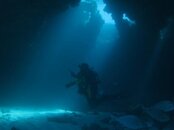DevonDiver
N/A
Not really, the problem with overhead environments is the overhead - there is no direct, immediate access to the surface. That situation fundamentally alters the safety of the diver.
It's easy to rationalize against that, especially with a little knowledge or experience. The mistake many people make when doing that rationalization is to underestimate risk. In regards to specific sites (rather than the general issue of overheads) is that it is easy to dismiss individual risks.
"If the site is 'big', I won't get trapped"
"If the site is 'sandy', I won't get a silt-out"
"If the site is well illuminated, I won't get disorientated"
"If I have adequate redundant gas, a failure isn't critical"
Running through a 'tick list' of hazards is appropriate, but it is not total. There are other factors to consider.
Firstly, there is psychology and response - how the individual diver reacts to problems - whether they have appropriate stress management and can end an accident chain, or whether they act inappropriately to amplify problems. Of course, we all like to assume that we aren't panic-prone or bad under pressure. Many will cite a few small examples in their lives as proof of they psychological robustness. Very few can do more than assume though.
Secondly, there is the issue of 'cascade' failures. This goes a long way beyond the simple tick-list above. It is the recognition that failures can, and often do, appear in unison, or at least that one failure can spawn others in a chain. It is simple to account for 'X' or 'Y' failures, but few account for 'X' plus 'Y'.
Lastly, there is the issue of human error. We all make mistakes. But many of us will deny doing so, even to ourselves. When we plan dives, we rarely account for the consequences of making a critical mistake.
The fact is that without immediate, guaranteed, direct access to the surface an unforeseen issue can be fatal. That represents a fundamental shift of incident surviveability. The overhead environment is essentially unforgiving.
What I've said may seem inapplicable to some. There will be denial, for sure. I can't convince anyone of my views via internet discussion. I can, and do, convince people of these realities on a daily basis in-water. That's my job. There's not a tech or wreck student that's been through my training that hasn't experienced a melt-down. It's easy to induce such melt-downs...and I don't do it through harassment.... I do it simply by loading simultaneous, realistic problems whilst also having task-loading the student with routine diving responsibilities. I've experienced it myself also...but not on any recreational course. Those were all 'high-fives' and 'well-done'.
It's easy to rationalize against that, especially with a little knowledge or experience. The mistake many people make when doing that rationalization is to underestimate risk. In regards to specific sites (rather than the general issue of overheads) is that it is easy to dismiss individual risks.
"If the site is 'big', I won't get trapped"
"If the site is 'sandy', I won't get a silt-out"
"If the site is well illuminated, I won't get disorientated"
"If I have adequate redundant gas, a failure isn't critical"
Running through a 'tick list' of hazards is appropriate, but it is not total. There are other factors to consider.
Firstly, there is psychology and response - how the individual diver reacts to problems - whether they have appropriate stress management and can end an accident chain, or whether they act inappropriately to amplify problems. Of course, we all like to assume that we aren't panic-prone or bad under pressure. Many will cite a few small examples in their lives as proof of they psychological robustness. Very few can do more than assume though.
Secondly, there is the issue of 'cascade' failures. This goes a long way beyond the simple tick-list above. It is the recognition that failures can, and often do, appear in unison, or at least that one failure can spawn others in a chain. It is simple to account for 'X' or 'Y' failures, but few account for 'X' plus 'Y'.
Lastly, there is the issue of human error. We all make mistakes. But many of us will deny doing so, even to ourselves. When we plan dives, we rarely account for the consequences of making a critical mistake.
The fact is that without immediate, guaranteed, direct access to the surface an unforeseen issue can be fatal. That represents a fundamental shift of incident surviveability. The overhead environment is essentially unforgiving.
What I've said may seem inapplicable to some. There will be denial, for sure. I can't convince anyone of my views via internet discussion. I can, and do, convince people of these realities on a daily basis in-water. That's my job. There's not a tech or wreck student that's been through my training that hasn't experienced a melt-down. It's easy to induce such melt-downs...and I don't do it through harassment.... I do it simply by loading simultaneous, realistic problems whilst also having task-loading the student with routine diving responsibilities. I've experienced it myself also...but not on any recreational course. Those were all 'high-fives' and 'well-done'.




